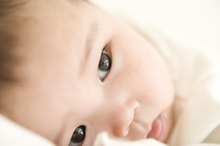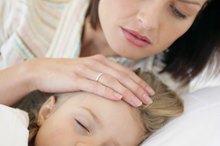What does fact checked mean?
At Healthfully, we strive to deliver objective content that is accurate and up-to-date. Our team periodically reviews articles in order to ensure content quality. The sources cited below consist of evidence from peer-reviewed journals, prominent medical organizations, academic associations, and government data.
The information contained on this site is for informational purposes only, and should not be used as a substitute for the advice of a professional health care provider. Please check with the appropriate physician regarding health questions and concerns. Although we strive to deliver accurate and up-to-date information, no guarantee to that effect is made.
Seal-Like Cough in Children
A loud, repetitive cough can be very scary for both children and their parents. According to KidsHealth, children with the croup have a loud cough, which often sounds like the barking of a seal 1. Although this cough may be alarming to you, it is not life-threatening.
If you are experiencing serious medical symptoms, seek emergency treatment immediately.
Croup
An inflammation of the upper airways, including the larynx and trachea, is a condition called croup. The croup leads to a barking cough or hoarseness. Croup is commonly caused by the parainfluenza virus, but may also be caused by adenovirus or respiratory syncytial virus, or RSV. Croup is most common in children six months to three years old.
- An inflammation of the upper airways, including the larynx and trachea, is a condition called croup.
- Croup is commonly caused by the parainfluenza virus, but may also be caused by adenovirus or respiratory syncytial virus, or RSV.
Symptoms
Croup In Teens
Learn More
Croup usually begins with a stuffy or runny nose and fever. When the upper airway becomes inflamed and swollen, your child may become hoarse and have a harsh, barking cough. As the airways become even more swollen, your child may have difficulty breathing, resulting in a high-pitched or squeaking noise when your child inhales. Your child may also breathe faster than normal. Croup symptoms are usually worse at night or during crying. Croup usually lasts three to seven days.
- Croup usually begins with a stuffy or runny nose and fever.
- Croup symptoms are usually worse at night or during crying.
Complications
Children normally recover from croup with no complications. Rarely, a child may develop a bacterial infection or pneumonia. Dehydration may also occur due to inadequate fluid intake.
Treatment
Causes of Kids' Breathing Problems
Learn More
Treatment for croup includes breathing moist air and ibuprofen or acetaminophen to make the child more comfortable. A cool-mist humidifier or a steam-filled bathroom may help stop the coughing. Steroids, prescribed by the doctor, may help reduce the airway swelling. Rest and plenty of fluids is usually recommended, according to KidsHealth.
- Treatment for croup includes breathing moist air and ibuprofen or acetaminophen to make the child more comfortable.
- Steroids, prescribed by the doctor, may help reduce the airway swelling.
Prevention
Prevention of croup and any other virus-causing illness includes frequent hand washing. You should also avoid contact with people who have respiratory infections to reduce the chance of spreading the virus that may cause croup 1.
Considerations
Contact your doctor if your child has difficulty breathing, rapid or labored breathing, has a high-pitched or squeaking noise when inhaling, is pail or bluish around the mouth, has difficulty swallowing, is fatigued or shows signs of dehydration.
Related Articles
References
- KidsHealth: Infections: Croup
- MayoClinic.com: Croup
- Johnson DW. Croup. BMJ Clin Evid. 2014;2014:0321. Published 2014 Sep 29.
- Smith, DS, McDermott, AJ, and Sullivan, JF. Croup: Diagnosis and management. American Family Physician. 2018;97(9):575-580.
- Downs, MR, and Hong, KTD. Is humidified air helpful in the management of croup in children? Evidence-Based Practice. 2015;18(6):E4. doi:10.1097/01.EBP.0000540996.17076.46
- Guppy MP, Mickan SM, Del mar CB, Thorning S, Rack A. Advising patients to increase fluid intake for treating acute respiratory infections. Cochrane Database Syst Rev. 2011;(2):CD004419 doi:10.1002/14651858.CD004419.pub3
- Baiu I, Melendez E. Croup. JAMA. 2019;321(16):1642. doi:10.1001/jama.2019.2013
Writer Bio
Lindsay Tadlock began writing in 2010. She has worked as a personal trainer for over three years and shares her fitness and nutrition knowledge in her writings. She graduated from Texas A&M University in 2000 with her Bachelor of Arts in finance and worked for seven years as a commercial lender.








